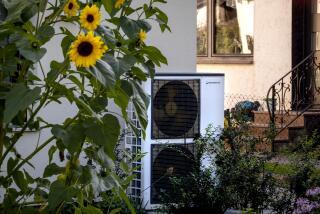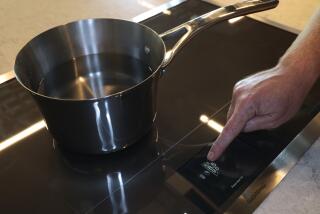It Pays to Replace Water Heater
- Share via
Question: Our old electric water heater does not leak, but we run out of hot water for morning showers. Would a new water heater help, and does it make economic sense to get a new one before the old one leaks?
Answer: It is often wise to replace an old (at least 10 years old) water heater with a new, super-efficient model. With new designs and better tank insulation, installing a slightly larger model to meet your morning hot water needs will still cut your utility bills. Older electric water heaters cost more to operate than most people realize.
For a typical family of four, replacing an old model at a 0.80 EF (energy factor) with a new one at a 0.94 EF saves about $100 a year. During its life, this compounds to more than $1,000.
Some of the most efficient models also use a “never-leak” design with lifetime warranties. These models have a spherical top, instead of the typical flat top, to provide extra-thick insulation where the water is hottest. Never-leak water heaters use all plastic and composite materials so there is no steel to rust near the water.
The inner tank, made of tough, stable polybutylene, is wrapped with multiple layers of wound fiberglass for strength. This inner assembly is then encapsulated in thick, rigid foam insulation.
The exterior shell is made of tough polyethylene plastic that resists dents and scratches. No anode rod is needed, so it does not create a water odor problem.
Some water heaters now include furnace-type setback clock thermostats that can use up to 15% less electricity. Others have new, efficient electronic controls with four settings: normal, scald-resistant, energy-saver and vacation/cabin.
The normal setting allows for any water temperature. To protect children and the elderly, the scald-resistant setting automatically adjusts the temperature. The energy-saver setting monitors your hot water usage patterns and modifies the heating cycles for the lowest utility bills. The vacation/cabin setting lowers the water temperature to 50 degrees to prevent freezing.
If space is limited and you cannot install a larger model, some new, high-quality models offer 5,500-watt (3,800 or 4,500 watts is typical) heating elements. These powerful 5,500-watt elements provide more hot water quickly.
Most steel water heater tanks have a thin inner glass lining to stop corrosion. Another effective design uses a half-inch thick stone lining to extend the tank life. The stone also adds a little more insulation value.
Especially in hard-water areas, select a model with larger, hand-size, sediment clean-out access holes. There are also special dip tube designs that swirl the incoming cold water to keep sediment from building up.
For more details, download at https://www.dulley.com Update Bulletin No. 568, a buyer’s guide of 12 manufacturers of super-efficient and never-leak electric water heaters.
Foil Under Attic Rafters Can Block Radiant Heat
Q: You had previously mentioned that stapling foil under the roof rafters would help block heat. I can only find single-sided foil with a paper backing. Which way should the shiny side face?
A: Stapling foil under the attic rafters will block radiant heat from a hot roof during the summer. During the winter, the roof does not get nearly as hot, so there is little negative effect from the foil. The shiny side should face downward, toward the living area.
Foil is effective, not because it reflects the heat back upward, but because the shiny (low emissivity) surface will not readily reradiate the heat to the attic floor below.
Dehumidifiers Don’t Lower the Temperature
Q: We use a dehumidifier during the summer when it is really humid. It seems to work a lot like a window air conditioner. Will running the dehumidifier help to keep the house cooler too?
A: Your house may feel cooler because of the lower humidity level from running a dehumidifier, but it actually is not. All the electricity the dehumidifier uses ends up as extra heat inside your house.
A dehumidifier does operate much like a window air conditioner, but it does not exhaust the heat outdoors. The savings result from being able to set the central air conditioner thermostat higher because of lower indoor humidity.
Follow Contractor’s Guidelines on Ducts
Q: We are building a new house. Our previous house had undersized heating ducts and it was noisy. Should we have the builder install ducts as large as possible to cut the noise and improve efficiency?
A: Small ducts with many bends can create a noisy situation; larger ducts are quieter. There is a limit to how large to go, so follow your contractor’s guidelines for sizing. If the ducts are too large, the air flow through them will be too slow for efficiency and comfort.
The routing of the ducts should have the minimum possible number of bends and joints. Make sure all the joints are well sealed.
*
Take an online tour of James Dulley’s house and see the many money-saving improvements and products that he tests. There are nearly 100 pictures with links to the various columns that describe the improvements and products. Go to https://www.dulley.com/house/ on the Internet.
More to Read
Inside the business of entertainment
The Wide Shot brings you news, analysis and insights on everything from streaming wars to production — and what it all means for the future.
You may occasionally receive promotional content from the Los Angeles Times.










